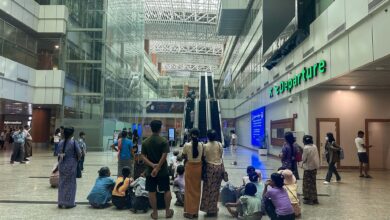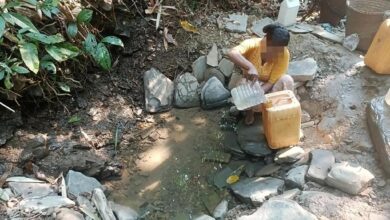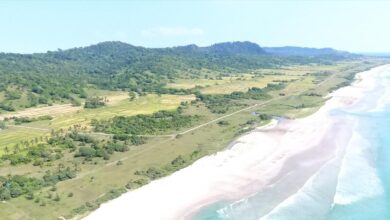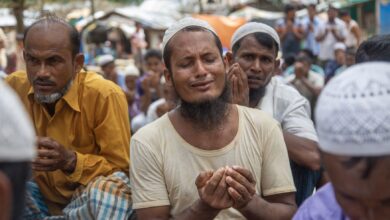
Armed resistance groups based in Chin State say they are expecting Myanmar’s military to mount a major offensive against them in the near future, as regime forces continue to pour into the state.
“They are likely to carry out more operations in the northern and southern parts of the state, considering how many reinforcements they’re sending,” said Salai Htet Ni, the spokesperson for the Chin National Front (CNF).
Resistance sources say that troops began arriving in northern Chin State’s Falam and Hakha townships from Kalay in Sagaing Region earlier in the month. More recently, a convoy of more than 90 military vehicles—reportedly including two tanks—has been making its way from Mindat to Matupi in the south.
Matupi is seen as a strategic crossroads linking all parts of the state, and as such is considered to be of great military importance. Three army battalions, including a tactical command, are based there.
“The road from Mindat to Matupi goes all the way west to Paletwa, and you can also get to the northern part of the state through Matupi. I think that’s why they’re sending a massive number of reinforcements here,” said Nway Oo Linn, the spokesperson for the Matupi chapter of the Chinland Defence Force (CDF).
Another reason may be the fact that the CDF-Matupi has carried out a number of successful attacks against the military since the beginning of the year.
The group says it attacked a military outpost in Theboi, a village on the Matupi-Paletwa road, four times between January 3 and 8, killing at least 10 regime soldiers and capturing two. It said it also used handmade explosives against junta troops on the Matupi-Hakha road on January 10.
In a statement, the group said it has also intercepted the convoy that left Mindat for Matupi on January 9 three times, killing four soldiers.
While there have been no battles since January 10, fighting is expected to resume very soon, according to Nway Oo Linn.
According to the Chin National Organization (CNO), another group based in the state, several other battles have also claimed the lives of at least 15 junta soldiers, bringing the total so far this year to 29, although this figure could not be confirmed.
Military tactics
To some extent, these attacks have slowed the progress of the military’s steady build-up in the state. But none of the resistance forces take comfort from this thought, as the situation continues to move towards a major showdown between the two sides.
“Because they’re planning to attack the entire state, I think they’re now coming in on paths that cut through jungle rather than along the main road. I’m guessing they’re going to attack Chin State before February 1,” said a spokesperson for the Chin National Defence Force (CNDF), the armed wing of the CNO.

Another tactic that the military has deployed is the use of human shields. According to the Zoland People’s Defence Force (PDF), which is active in the northern part of the state, a convoy of five military vehicles carrying around 100 soldiers that left Kalay on January 12 forced 10 civilian vehicles to travel together with them as they entered Chin State.
“They blocked the road at the exit from Kalay and made the other vehicles wait there. Then they went along with the travellers,” said a spokesperson for the Zoland PDF.
Soldiers travelling on foot have also done the same, abducting local people and forcing them to walk ahead of their columns. On January 6, junta troops passing through the village of Keihlung in Matupi Township seized 11 civilians, including a 13-year-old child, for this purpose. They later killed 10 of them, including the child, leaving their bodies behind on the road.
In a statement released on January 13, the CNDF reported a similar incident in Waibula, in Falam Township, where five people were abducted by soldiers. Two were later released, but three were used as human shields, the group said.
According to CNF spokesperson Salai Htet Ni, the regime is not just abusing local people, but also trying to create a wedge between them and the resistance forces.
“They’re cutting off communication between the local defence forces and the people and making the people unable to fund the defence forces,” he said.
Resistance advantages
Despite these tactics, however, the resistance forces insist that they remain in a strong position to fend off anything the junta can throw at them.
One obvious advantage they have is a superior knowledge of the local terrain, which makes it easier for them to ambush troops passing through their territory.
Another is the fact that the many disparate groups that took up arms against the regime last year are now better organized and more battle-hardened.
“The local defence forces are made up of young people who had no military experience at all last year. But it has now been a year and they’ve become a lot more mature,” said the CNF’s Salai Htet Ni.
“We are going to fight back against the military no matter how much force they use. We are doing our best to prepare right now,” he added.
As an ethnic armed organization formed in 1988, the CNF was well-placed to train a new generation of anti-regime forces. Despite being a signatory to the now-defunct Nationwide Ceasefire Agreement, it wasted no time in stating its opposition to the newly installed junta.
The CNF was also among the first armed groups in Myanmar to declare that it would stand by the shadow National Unity Government (NUG), formed by ousted lawmakers and other civilian opponents of the regime after last year’s coup.
So far, however, the CNF and other armed groups in Chin State have yet to receive any significant support in terms of weapons from the NUG, according to Salai Htet Ni.
Nway Oo Linn, the CDF-Matupi spokesperson, also made this point, noting that the need for military support is becoming increasingly urgent, especially as the military steps up its use of airstrikes to neutralize resistance forces.
“We would like to tell both the NUG and the international community that the military is going to accelerate their attacks,” he said.
“We need not only more men but also more weapons. We need everyone’s support,” he added.



